Disregard the attractive price tag for a moment, because Suzuki have uprated the 150-hp naked bike for 2021. The engine is now Euro 5-compliant, revs an extra 1,000 rpm, and, although quoted peak torque is down, Suzuki assure us the torque curve is smoother and fatter than earlier. There are new electronics, a new dash, an up-and-down quick-shifter as standard, and conventional traction control (TC) with greater refinement. There is a bold new look as well
This is more of a tweak than a complete overhaul and, remember, the roots of this engine date back to the GSX-R1000 K5 from 2005. Capacity, bore and stroke, and compression are the same as before, with new camshafts, camchain, and valve springs, along with a new slipper clutch among the most significant changes. There is also a completely new exhaust (to meet Euro 5 norms) along with smaller and lighter electronically controlled throttle bodies. The 40-millimetre throttle bodies (down from 44 mm) have been designed to give a smoother feeling upon opening.
The end result is an increase from 150 hp at 10,000 rpm to 152 hp at 11,000 — not a huge step. However, the increase in rpm is interesting. Peak torque is down from 108 Nm at 9,500 rpm to 106 Nm at 9,250 rpm, but the all-important torque curve is now smoother, with a noticeable increase in the mid-to-high rpm range.
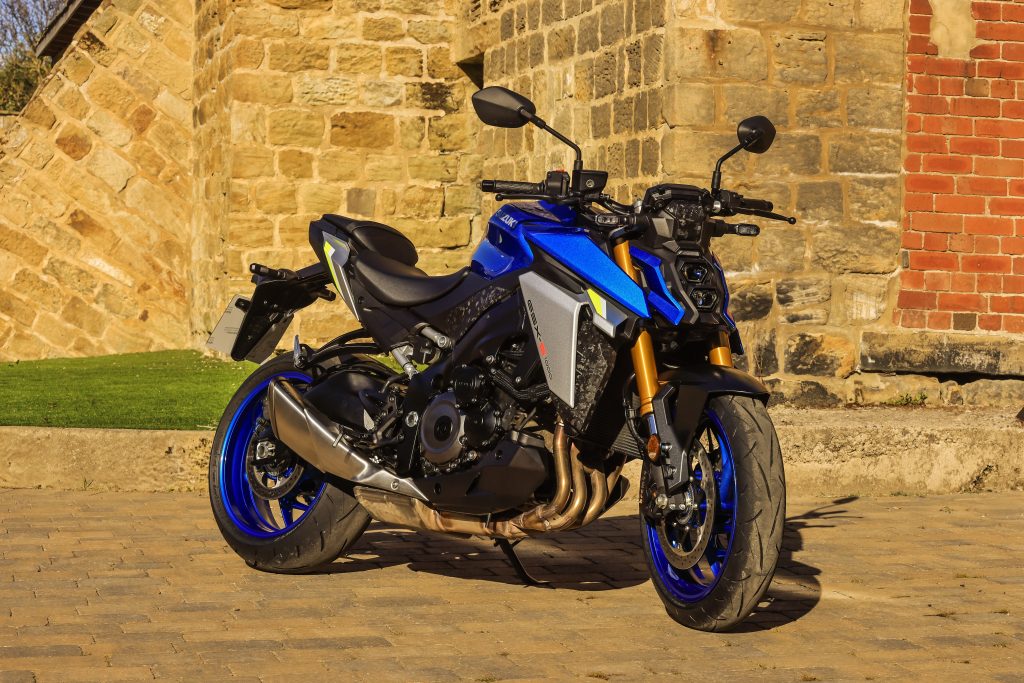
The Suzuki sounds a little old school and makes a charismatic induction noise much like an older GSX-R1000. I do not mean this to be derogatory, far from it. I have always liked the sound of the in-line four-cylinder; it sounds meaty.
There are three simple riding modes to choose from which change the engine character
and power curves, but still give full power. The modes have always been called A, B, and C, but now someone in marketing has decided they are Active, Basic, and Comfort. Suzuki have in the past been criticised for having sharp or aggressive fuelling, but that has been mainly rectified in the new 2021 model.
A (or Active) is still a little too sharp and I am unsure why you would ever need it. Some riders may prefer a snappy throttle, but I opted for the softer B mode on the road and track. C… sorry, Comfort … offers a noticeable change and would be ideal for inexperienced riders or when conditions are tricky or you are on new rubber. But I spent 95 per cent of the test in the B… sorry, again… Basic mode.
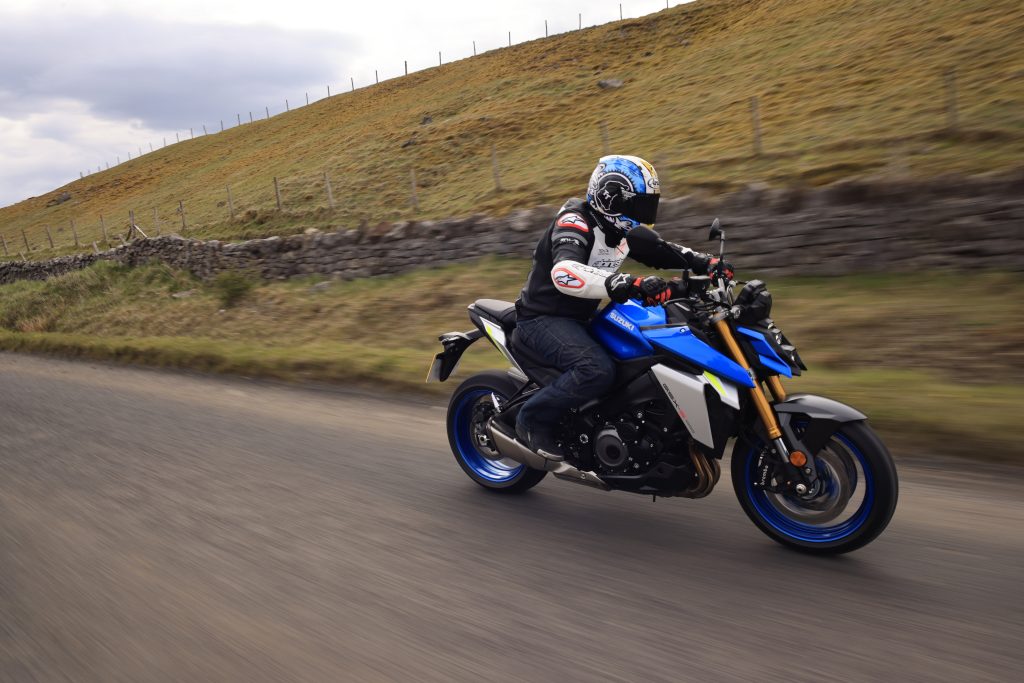
The change in peak power between the old and new bike is hardly detectable, but the change in torque is. I was pleasantly surprised by the drive from the four-cylinder GSX-R1000-derived motor. Low-end torque has increased a fraction, but it is the mid-range that was impressive. It drives like a bike with a larger capacity and with real grunt — I like it. A few times I flicked back a few gears on the now standard up-and-down quick-shifter for a brisk overtake when it really was not necessary. The quick-shifter works smoothly and, again, is a bonus in the 2021 model. Ride the torque, drink in the charismatic exhaust note — for a Euro 5-compliant bike, it does not sound half bad — and have fun.
If you want to get your head down and chase your mates on their far less comfortable sport bikes, the GSX-S1000 will deliver. It now revs 1,000 rpm higher to its soft rev limiter and is quicker than I expected. I am unsure why, but I did not think it would be this grunty, but then I remember what the old GSX-R1000 K5 was like and that even in today’s world, 150 hp is still more than enough.
With the TC deactivated, which can be done on the move, a whiff of clutch will send the front wheel skywards in the first two gears and even in third with some aggression. The no-nonsense engine makes this a fun, usable bike — happy to ride along using its torque or hang on to much sportier machinery.
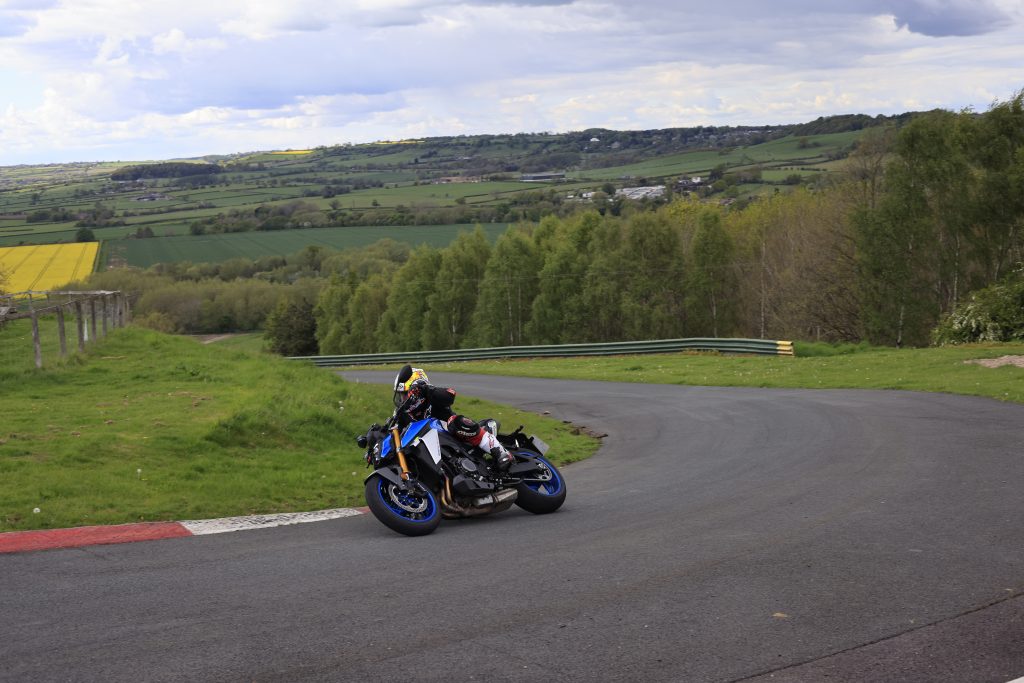
Suzuki split our test ride into two parts. A brisk 160-km ride around North Yorkshire in the north of the United Kingdom on a real mixture of roads, followed by numerous runs up the notorious 1.45-km Harewood Hill Climb, a historic hill-climb in Yorkshire with a combination of 11 tight turns. That was a brave move by Suzuki to send the big GSX-S up the hill on standard suspension settings and Dunlop Sportmax Roadsport 2 rubber, which is new for this year. We did not even lower the tyre pressures.
In the stunning Yorkshire scenery, I am in a happy place. The fully adjustable 43-mm KYB forks feel controlled, the rear shock is behaving. The suspension on the 2021 model is the same as that on the previous model but with revised settings to take the extra weight and torque and improved grip offered by the new Dunlop rubber. At normal speeds, I have very few complaints, taking the picturesque but demanding roads with ease.
It is only when you start enjoying the full 152 hp that the suspension’s limitations become more apparent. The showroom settings work effectively during normal riding and the front set-up is rather impressive, especially considering the price tag. But hit some undulations at speed and the rear shock sits like an obedient dog. Throw in some fast, bumpy corners and you can feel it working overtime. However, it is only when you ride aggressively that you find the limitations of the rear shock.
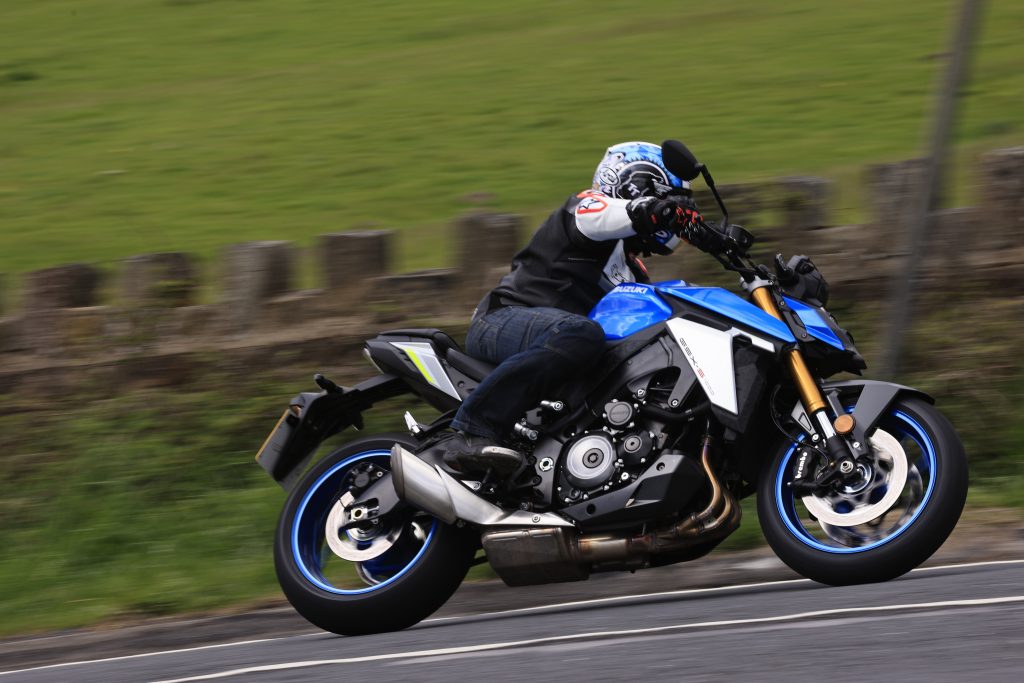
Then we have a small issue with weight. Adding LED lights, a Euro-5 exhaust system, and a larger fuel-tank (up three litres to 19 litres) has added weight to the Suzuki, which was already due a diet. If you are jumping from the competition, such as BMW’s S 1000 R or Ducati’s Monster, you are really going to notice the physicality of the new Suzuki. But saying that, despite gaining
a few pounds in its old age, the Suzuki still steers well and that weight gives a robust feel to the handling.
After a brisk road ride, I was concerned the GSX-S1000 may be out of its depth on the demanding hill-climb, which is fast in places, just touching 160 km/h with no room for error. However, the new Suzuki took to the challenge with surprising ease. Again, the steering was reassuring and accurate, the forks did not bottom out during vicious braking, and everything was controlled and managed. The new Dunlops remained unfazed and, on a relatively smooth surface, the rear shock was well behaved and gave enough feedback to allow me to get on the power sooner and sooner. I assumed the Suzuki was going to be embarrassed on this tight and twisty hill climb, but it was not.
The pegs eventually started scraping and it is by no means a race bike, but considering the bike’s weight, power, and price, Suzuki have done an eye-opening job of setting the bike up for all eventualities from the off. The Brembo stoppers remain the same as the previous model’s and grab twin 310-mm discs. Like the suspension, they are more than up for the job and have a nice feel to them. It is only when you start to ride the big Suzuki out of its design parameters that you find faults.
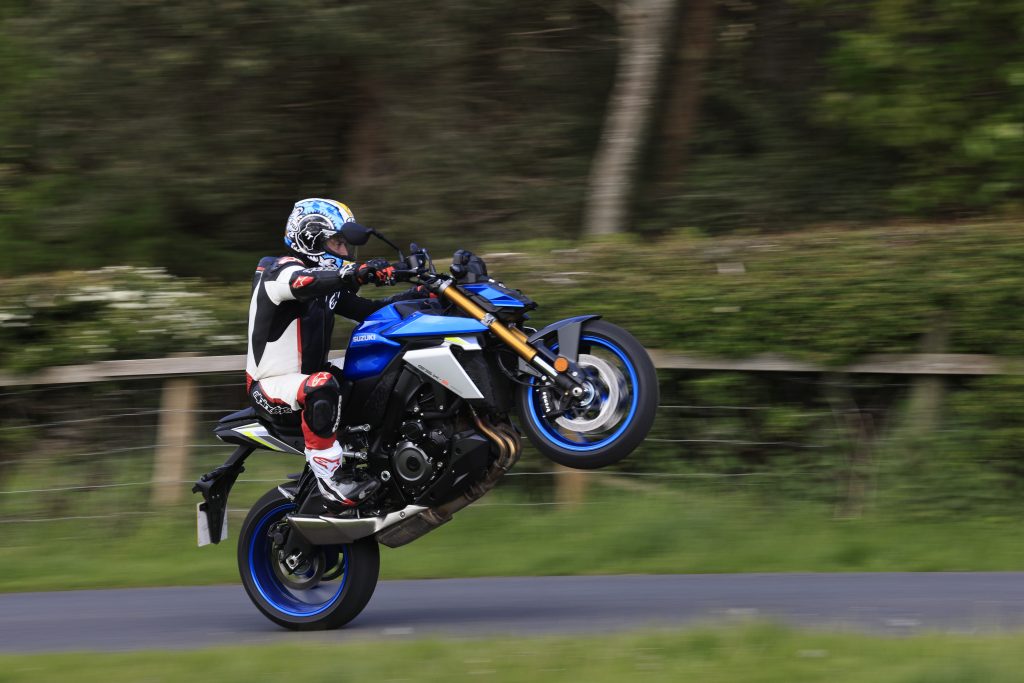
ABS is standard, though not lean-sensitive. And although you have a new slipper clutch, there is no engine brake assist or many of the electronic rider aids you now find in some of the competitors. Attacking the hill-climb, the ABS was a little obtrusive, but, again, we were really pushing the limitations of the bike.
If you are fully loaded, two-up with luggage, and stopping from motorway speeds into a tight off ramp, the stoppers may feel a little lacking and the absence of lean-sensitive ABS may perturb a few new customers, too. But considering the price and the target audience of this bike, they are up for the job.
Obviously, a naked is not going to be brilliant for comfort, but Suzuki have made the bike more versatile and comfortable than before. The tapered bars are now 23 mm wider and 20 mm closer to the rider, thus creating a more upright position for the rider. The now larger 19-litre fuel-tank has also been reshaped to increase comfort and offer a greater tank range.
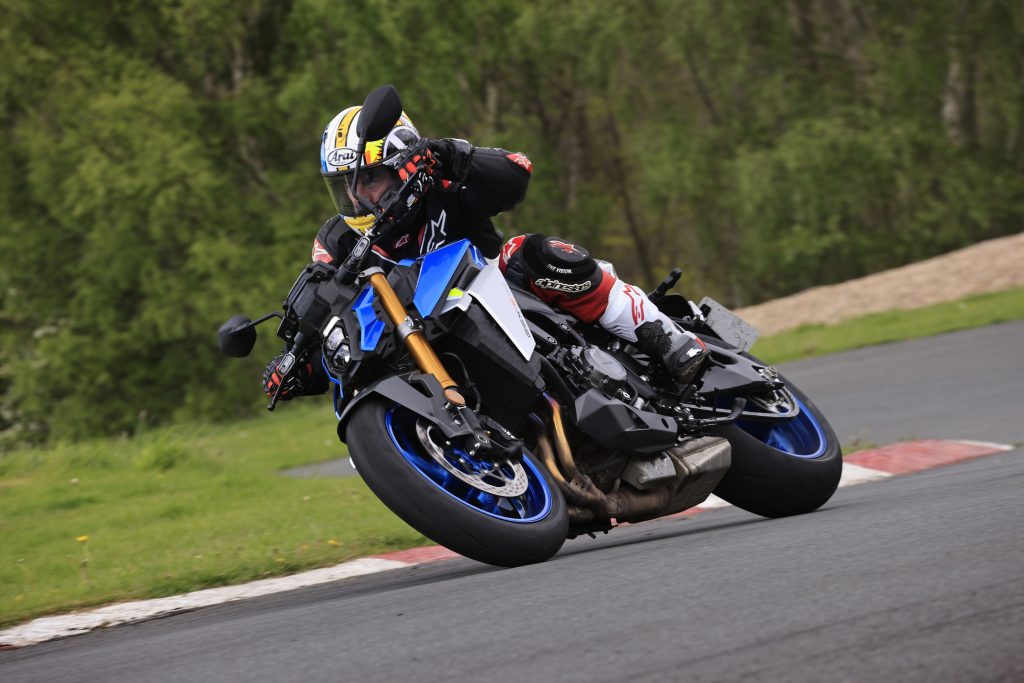
While we are talking of fuel figures, Suzuki quote 16.4 km/l, down from the previous official figure of 18.9 km/l. A quick bit of maths gives a theoretical tank range of 373 km, up from 320 km previously. On that swift road ride, I managed 17.3 km/l, above Suzuki’s claimed figure, with a theoretical range of 394 km.
Our road ride was only 160 km long and, obviously, we would like to add more miles before categorically commenting on long-range comfort. Nevertheless, it is nice to see that Suzuki have fitted an actual seat, rather than a race seat as on some of the competitors, and the pillion even gets a reasonable-looking perch. Of all the bikes in this category, and based on a first impression, the Suzuki scores highly for those who spend a considerable time in the saddle.
The list of what Suzuki does not have is far longer than what it has. No IMU to determine lean angle and, therefore, no lean-sensitive rider aids and so conventional ABS and traction control only. No engine brake assist, no pit-lane limiter, no cruise control, no anti-wheelie, no slide control, no cornering ABS, no huge TFT clocks… It is relatively basic and slightly behind its competitors like BMW’s new S1000R, for example.
Suzuki have added simple and easy-to-use multifunctional clocks, an up-and-down quick-shifter (which works perfectly) as standard, and there is Suzuki’s unique easy start and low-rpm assist, which increases the revs slightly as you release the clutch. The LED headlights are a nice touch too.
Suzuki have not reinvented the wheel. If they had increased capacity or added more tech sich as an IMU, which would have brought lean-sensitive rider aids, the price would have increased – which was not the aim for Suzuki. Producing an affordable, attractive, usable naked road bike was key – which is precisely what they have done. This is still a 150-hp naked bike, more than capable on the road and even on track – up to a point. The engine has grunt, the rider aids are just about sufficient, and the motorcycle has been priced very competitively. You could argue it is basic and some riders who are coming down from superbikes with much higher specs may be put off, but I believe most riders will like its simplicity and everyday usability.


Leave a Reply